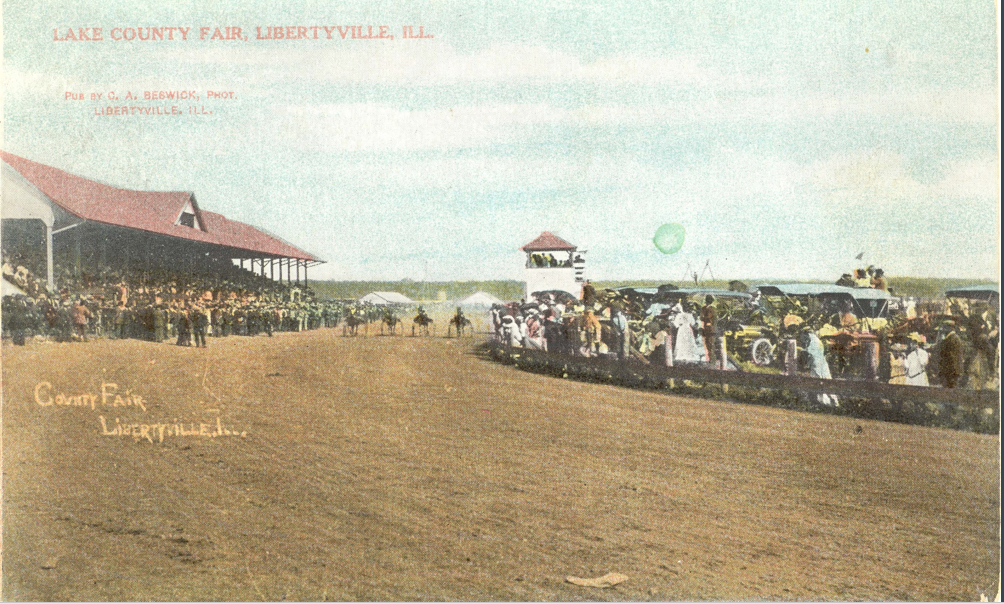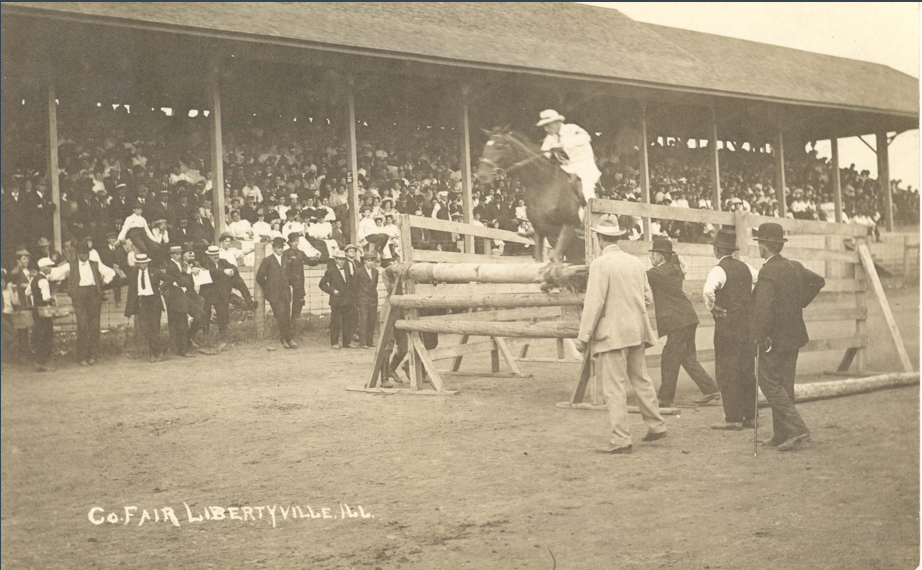If thoroughbred racing is the Sport of Kings, harness racing, also known as trotting, could be called the sport of the people. Anyone could train their horse to trot and the cost of entry to the sport was much lower than that of thoroughbred racing.
In harness racing, instead of a rider atop a horse, a horse pulls a two-wheeled cart called a sulky. Originating as simple street races between two or more racers and their personal wagon or carriage horses, the popularity of harness racing grew in the nineteenth century as it became associated with agricultural fairs. In addition to showing their animals in the hopes of winning a prize or premium in various categories, farmers could enter their horses in speed trials to further demonstrate the superiority of their breeding [1].
Increasingly, the races became a major attendance draw and a permanent part of fair competitions in addition to “best of categories” of animals, agricultural products such as best butter made in the county, quilts, embroidery, and art.
So its not a surprise that the Lake County Agricultural Society picked up the trend early in the history of the Lake County Fair.

The first Lake County Agricultural Fair was held in Waukegan in 1852, and again in 1853, but farmers from around the county found traveling to the far east burdensome. Libertyville won a bid to host the fair in 1854 at a local farm, but Waukegan stirred up enough opposition to return the fair to that town from 1855 – 1857.
By 1858 farmers west of the Des Plaines River who wanted a central fair location had enough votes to return the fair to Libertyville. The Lake County Agricultural Society leased 10 acres of land located at the Lake County Poor Farm which was at the current site of Milwaukee and Winchester Roads [2].

This bird’s eye view from an 1873 lithograph features the fairgrounds at the bottom showing a barn and stables in the middle of the ⅓ mile track.
Little is known about this early track, but a recollection by Captain John Swanbrough, a Civil War veteran and 4-time Lake County Sheriff, was published in the Libertyville Independent on October 4, 1917. He was celebrating 50 years of horse racing at the County Fair. He began in 1867 at the Third-Mile track and he recounted an early race there.

He said: “It so happened that when the race in question was called, no horses lined up except [all] those I owned myself: Creeper, Creeper Boy, Seneca Chief and Jessie…It wasn’t planned that way, but happened.”
The Captain went on to say that Seneca was his favorite and he wanted him to win. However, Creeper’s driver was confident he could win, refused instructions to pull back and his horse won. Captain Swanbrough joked that he couldn’t complain since all of his horses placed [3].
The fair, along with horse racing, remained at this site until 1881. Today it is a campus of various Lake County buildings.
A quick side note: we’ve all probably seen or heard of the dangers to thoroughbred horse jockeys, but harness racing is not free from peril. In that same 1917 newspaper issue, the lead headline was “Racing Accident Ends Fortunately.”

When one horse swerved into another, the “melee” that followed led to three drivers being thrown from their sulkies and dragged down the track up to 90 feet. Fortunately, the men sustained only relatively minor injuries. But one of the horses took an additional three laps around the track with a broken sulky trailing behind it before being corralled [4].

At the end of 1881, for some reason the Lake County Board of Supervisors voted to demand that the Lake County Agricultural Society vacate the County Farm land [5]. The Society searched for a new home for its fair. With the financial aid of John Locke, soon to become Libertyville’s first mayor, the Society landed on 16 acres of Appley family farm and 6 acres of Galloway family farm land, located at the northeast end of town where Lake Minear is today.
Everything was larger at this new site. The track size increased from ⅓ mile to a ½ mile and a large grandstand was constructed to accommodate the crowds. Here we can see the grandstand with an overflow crowd of men and women sometime before 1910. There are even race watchers leaning out of the opening at the peak in the roof.

The track was considered to be one of the finest in Northern Illinois and it started attracting the best racers in the area. Trotting and pacing races, delineated by the different gaits used by the horses, were the mainstay of the race course.

In this 1920 race program from the Libertyville Historical Society collection, a spectator has recorded the winning horses and their times.

Over the years, the race track was also used for other horse events and other types of racing. Here is a postcard of a rider and horse in a hunters or steeplechase competition. Thoroughbred racing, or running races, also made an appearance.


Car racing debuted at the 1923 Lake County Fair featuring Ford race cars [6]. The track was also used for motorcycle races at least once as evidenced by this advertisement and newspaper article of an American Legion event in 1925 which sounds amazing [7].

A flying circus with trapeze artists hanging from planes! Parachute drops! And a match between the Illinois and Wisconsin state fair auto polo teams!

Although well attended, the fair had been a losing proposition for a few years and the earnings were not enough to cover a debt and a mortgage. Hints of a possible foreclosure made the newspaper in late 1924 [8]. With Libertyville in the midst of a post-WWI development boom, it was suggested the fairgrounds property was well located for a new subdivision. It was also known that a large supply of gravel lay not far beneath the surface.
In 1925, “fast running horses” replaced what the newspaper called “the dying harness races,” but it was too little, too late. This was the last year of the fair at this location and the property went on the auction block in January 1926 [9].
The Lake County Fair found a new home in Antioch where it was held from 1928 until 1947 [10].
A few more non-fair events were held on the Libertyville fairgrounds before the buildings were demolished in late 1927 by the winning bidder, North Shore Material Company [11]. The site was mined for gravel by the company which was later taken over by The Consumer’s Co. [12] Local lore says that the quarry sprung a leak and filled up to become what is now Lake Minear. Whether that is true or gravel operations simply ceased at that location and the pit was allowed to fill is not clear.

A different kind of racing – outboard motor boat racing – seemed a possibility on the new lake in the early 1950s, but plans appear to have petered out after protests from nearby homeowners about the noise and traffic at a demonstration race attended by thousands of people [13].
In part 2 of Libertyville’s Racetracks, the last, and biggest, of the racetracks of Libertyville, the One Mile Track constructed by the Libertyville Trotting Association, will be discussed.
Part 2: Libertyville’s Racetracks
Many of the following sources used in this post can be found in the Cook Memorial Public Library District collection.
Sources:
- Betts, John Rickards. “Agricultural Fairs and the Rise of Harness Racing.” Agricultural History, April 1953, Vol. 27. No. 2, p. 71-75.
- Dretske, Diana. “Let’s All Go to the Fair.” Lake County History Blog, July 31, 2009. http://lakecountyhistory.blogspot.com/2009/07/lets-all-go-to-fair.html. Accessed April 26, 2023.
- “Civil War Hero Starting Judge at Fair Races.” Waukegan News Sun, September 29, 1917, p.1. Newspapers.com.
- “Racing Accident Ends Fortunately.” Waukegan News Sun, September 29, 1917, p.1. Newspapers.com.
- “The Supervisors: Proceedings of the Board at Their Meeting Last Week.” Waukegan Weekly Gazette, December 17, 1881, p. 1. Newspapers.com.
- “Fair Board Ready for Record Exhibition: Something of Interest to Everybody.” Lake County Register, August 29, 1923, p. 1. Newspapers.com.
- “Libertyville Fairgrounds, Sunday, September 27, Auspices of the American Legion.” Advertisement. Libertyville Independent, September 24, 1925, p. 4. Newspapers.com.; “5,000 Attend Big Legion Show at Libertyville.” Libertyville Independent, October 1, 1925, p.1. Newspapers.com.
- “No Foreclosure Likely; Woodin is to Save Grounds.” Libertyville Independent, December 4, 1924, p.1. Newspapers.com.
- “County Fair Opens with List Filled.” Lake County Register, September 5, 1925, Section 2, p.1 Newspapers.com; “Will Sell Fair Land on Jan. 16.” Lake County Register, December 30, 1925. p. 1. Newspapers.com.
- Dretske, “Let’s All Go to the Fair.”
- “Fairgrounds Buildings Being Wrecked: To Open Gravel Pit.” Lake County Register, October 12, 1927, p. 1. Newspapers.com.
- “Wonder How Lake Minear Got That Way?” Independent Register, July 14, 1960, p. 9S. Cook Library Local History File; Michaels, Joseph. “Lake Minear.” Unpublished manuscript. November 11, 1974. Cook Library Local History File.
- “Reveal Plans for Outboard Racing at Gravel Pit.” Independent Register, September 11, 1952, p.1. Cook Library Local History File; “Irate Residents Protest Noise of Outboard Races.” Independent Register, October 9, 1952, p.1. Cook Library Local History File.
Discover more from Cook Memorial Public Library District
Subscribe to get the latest posts sent to your email.
Categories: Local History
Tags: Local History
